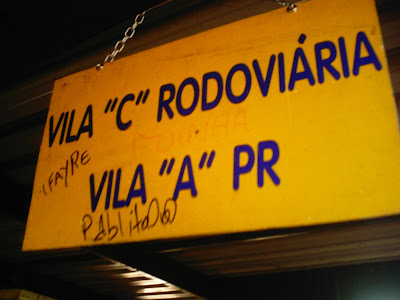To the Vilas of Itaipu


Bus To Vila "C" Via Rodoviária (Intl. Bus Terminal)
Top photo show a typical arched,tin-roofed,warehouselike dwelling now turned into neighborhood business offering narbecue on weekends
Still Platform One / Side Two
The Vilas of Itaipu
The second bus stop on Platform One / Side Two is also interesting for the international traveler. It is the stop for the buses going to Vila “C”. Vila is not in the sense you know like an Italian Villa in Tuscany etc. Vila is nearly the same is “bairro”, a neighborhood. Vila “C” was one of three “Vilas” built to house Itaipu Construction workers. The others were Vila “B” and Vila “A”. Vila “B” was built for the white-collared administrators, engineers and skilled professionals, mostly called Doctors. Each house in vila “B” is a little mansion. Vila “A” was built for the blue-collared worker, administration clerk and bureaucrats. The Vila “A” neighborhood can be easily seen today, streets are tree-shaded and spacious, there are plenty of children parks with toys, thickets and remains of original forest were left and houses are nice and comfortable.
The Vila “C” was something else. The jungle was cleared, the red soil exposed and I saw a conglomarate of arched, tin-roofed warehouse-type buildings be sown over the then seemingly far away hard-to-live-in expanse of red-soiled nothingness. Each warehouse was meant to house four families. So the inside of the warehouse was subdivided and turned into four houses. People had to do what they could in order to come up with ideas to make brickwalls and wooden ceilings become sound proof so that families and mainly couples could have privacy in the extremely hot summer nights of Foz do Iguaçu.
Little by little after the Dam was finished, creativity and effort transformed the old warehouse-like buildings into separate houses. Today it takes a good pair of observing eyes to still see the tin-rooffed wareghouses here and there. Thse bus laving from this stop and going to Vila “C” will also go to the Bus Station (rodoviária). This can be a good option for the buses going to Tres Lagoas – Gleba Guarani Area – in case they are crowded. From this stop you can board buses also going to the Vila “A”, via Avenida Paraná – remember the INSS, IML note?
Today all of the three Itaipu’s “Vilas” (A, B & C) have been surrounded by “bairros” that have grown ever since thanks to the entrepreneurial zeal of land developpers and why not? Speculators. Newer neighborhoods that sprung from this entrepreneurial zeal include the conglomerate known as AKLB short for the neighborhoods of Aporã, Karla, Lancaster and Barbara and the area known as the Ipê Gardens (Jardim, not actually gardens) I & II. The Vila “A” mainly along its main street, Silvio Americo Sasdelli, tends to have a considerable family nightlife with places for icecream, pizzas, snacks and so on. Beware: buses in the night tend to be far apart or even chaotic. If you have a way to go there and return, this is a good place to see Iguaçuenses (Iguaçuans) at home.



Comments